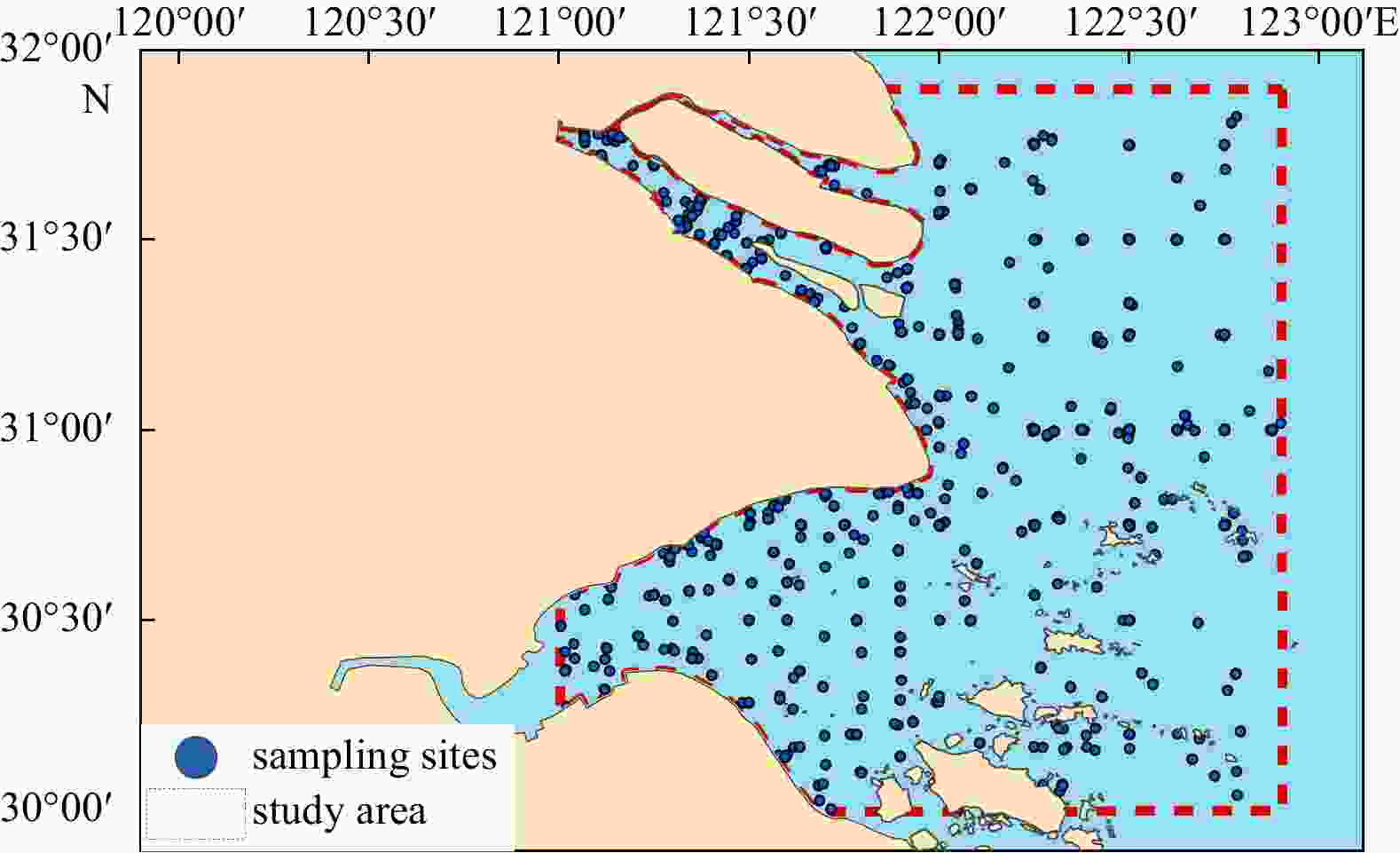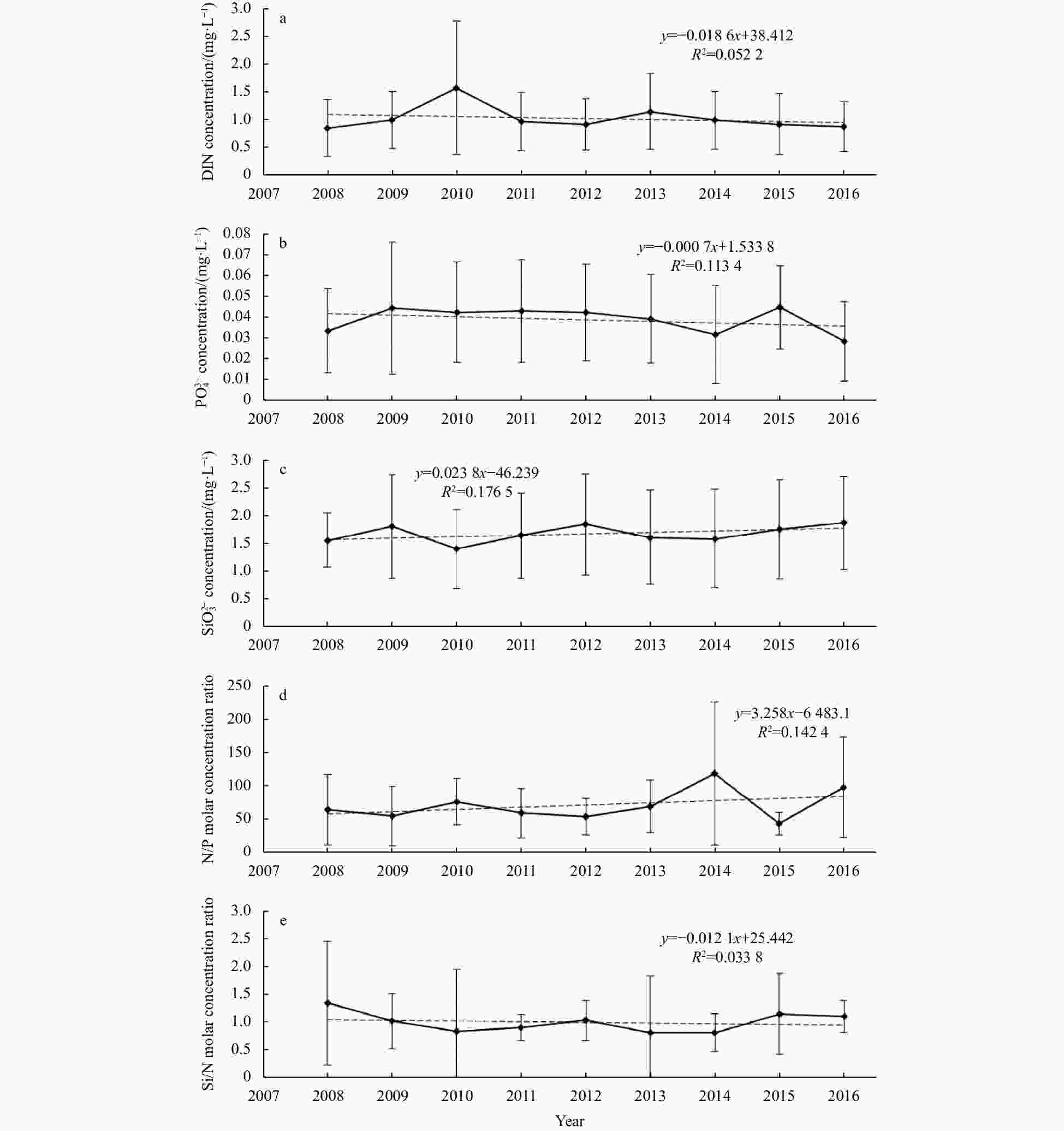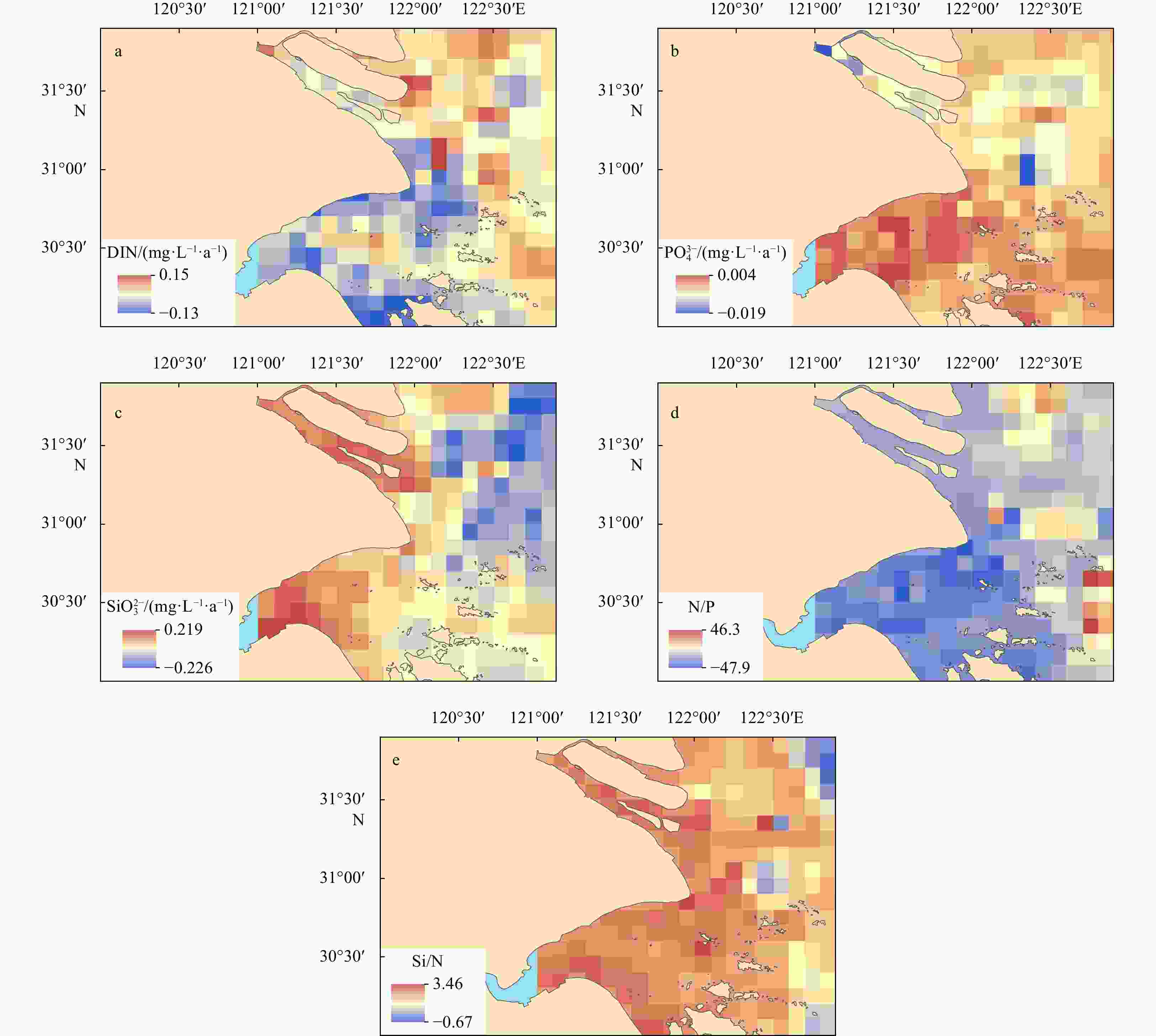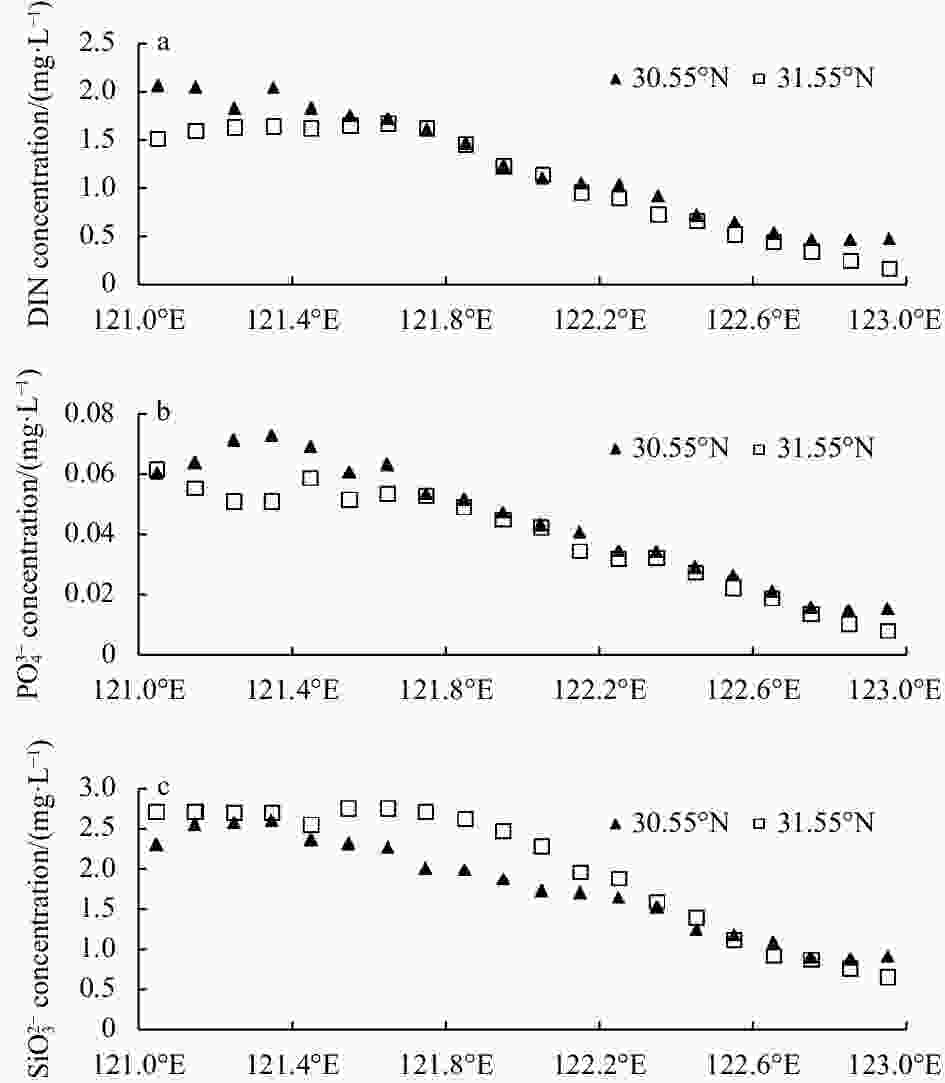Spatiotemporal changes of biogenic elements in the Changjiang River Estuary and adjacent waters in summer over the last decade
-
Abstract: The long-term spatiotemporal changes of surface biogenic elements in the Changjiang River Estuary and adjacent waters during the summer of 2008−2016 were analyzed in this study. The concentrations of dissolved inorganic nitrogen (DIN), soluble reactive phosphate (
${{\rm {PO}}_4^{3-}} $ ) and silicate (${{\rm {SiO}}_3^{2-}} $ ) were generally stable, with a slight decrease of DIN and${{\rm {PO}}_4^{3-}} $ , and a slight increase of${{\rm {SiO}}_3^{2-}} $ , which mainly occurred in the estuarine waters. The grey correlation analysis was carried out between biogenic elements and chlorophyll a (Chl-a). Results showed that compared with the absolute values of biogenic elements, the correlations between the concentration ratio of nitrogen to phosphorus (N/P), ratio of silicon to nitrogen (Si/N) and Chl-a were closer, indicating the important influence on phytoplankton by the structure of biogenic elements. The study area was generally in a state of potential P limitation, and could have potential impact on the phytoplankton community, triggering the shift of red tide dominant species from diatoms to dinoflagellates.-
Key words:
- Changjiang River Estuary /
- biogenic elements /
- spatiotemporal changes
-
Figure 3. Spatiotemporal changes of surface biogenic elements in the Changjiang River Estuary and adjacent waters by grids during the summer of 2008−2016. a. DIN concentration change; b.
${{\rm {PO}}_4^{3-}} $ concentration change; c.${{\rm {SiO}}_3^{2-}} $ concentration change; d. N/P molar concentration ratio change; e. Si/N molar concentration ratio change.Figure 4. Spatial distribution of surface biogenic elements in the Changjiang River Estuary and adjacent waters during the summer of 2008−2016. a. DIN concentration; b.
${{\rm {PO}}_4^{3-}} $ concentration; c.${{\rm {SiO}}_3^{2-}} $ concentration; d. N/P molar concentration ratio; e. Si/N molar concentration ratio.Table 1. Correlation between biogenic elements and chlorophyll a
Factors Grey correlation degree Rank DIN concentration 0.744 4 ${{\rm {PO}}_4^{3-}} $ concentration 0.566 5 ${{\rm {SiO}}_3^{2-}} $ concentration 0.854 3 N/P molar concentration ratio 0.924 1 Si/N molar concentration ratio 0.922 2 Table 2. Biogenic elements limitation in the Changjiang River Estuary and adjacent areas
Year N limitation P limitation Si limitation 2008 0.3% 98.0% 0.6% 2009 0.8% 93.8% 2.0% 2010 0 86.3% 0 2011 0 99.2% 0 2012 0 96.9% 0 2013 0.3% 97.8% 0.3% 2014 0 99.7% 0 2015 0.3% 91.9% 0.3% 2016 0 99.2% 0 -
Anderson D M, Glibert P M, Burkholder J M. 2002. Harmful algal blooms and eutrophication: nutrient sources, composition, and consequences. Estuaries, 25(4): 704–726. doi: 10.1007/BF02804901 Bianchi T S, Allison M A. 2009. Large-river delta-front estuaries as natural “recorders” of global environmental change. Proceedings of the National Academy of Sciences of the United States of America, 106(20): 8085–8092. doi: 10.1073/pnas.0812878106 Boyce D G, Lewis M R, Worm B. 2010. Global phytoplankton decline over the past century. Nature, 466(7306): 591–596. doi: 10.1038/nature09268 Chen Dong, Dai Zhijun, Xu Ren, et al. 2015. Impacts of anthropogenic activities on the Changjiang (Yangtze) estuarine ecosystem (1998–2012). Acta Oceanologica Sinica, 34(6): 86–93. doi: 10.1007/s13131-015-0679-7 Chen Huimin, Sun Chengxing, Wu Yanqing. 2011. Analysis of trend of nutrient structure and influencing factors in Changjiang Estuary and its adjacent sea during 23 years. Marine Environmental Science (in Chinese), 30(4): 551–553,563 Chen Hongtao, Yu Zhigang, Yao Qingzheng, et al. 2010. Nutrient concentrations and fluxes in the Changjiang Estuary during summer. Acta Oceanologica Sinica, 29(2): 107–119. doi: 10.1007/s13131-010-0029-8 Dai Zhijun, Fagherazzi S, Mei Xuefei, et al. 2016. Decline in suspended sediment concentration delivered by the Changjiang (Yangtze) River into the East China Sea between 1956 and 2013. Geomorphology, 268: 123–132. doi: 10.1016/j.geomorph.2016.06.009 Falco S, Niencheski L F, Rodilla M, et al. 2010. Nutrient flux and budget in the Ebro Estuary. Estuarine, Coastal and Shelf Science, 87(1): 92–102 Furuya K, Hayashi M, Yabushita Y, et al. 2003. Phytoplankton dynamics in the East China Sea in spring and summer as revealed by HPLC-derived pigment signatures. Deep-Sea Research Part II: Topical Studies in Oceanography, 50(2): 367–387. doi: 10.1016/S0967-0645(02)00460-5 Gao Shengquan, Chen Jianfang, Jin Haiyan, et al. 2011. Characteristics of nutrients and eutrophication in the Hangzhou Bay and its adjacent waters. Journal of Marine Sciences (in Chinese), 29(3): 36–47 Gao Shengquan, Lin Yan, Jin Mingming, et al. 2004. Distribution features of nutrients and nutrient structure in the East China Sea and the Yellow Sea in spring and autumn. Donghai Marine Science (in Chinese), 22(4): 38–50 Jiang Zhibing, Liu Jingjing, Chen Jianfang, et al. 2014. Responses of summer phytoplankton community to drastic environmental changes in the Changjiang (Yangtze River) Estuary during the past 50 years. Water Research, 54: 1–11. doi: 10.1016/j.watres.2014.01.032 Justić D, Rabalais N N, Turner R E. 1995. Stoichiometric nutrient balance and origin of coastal eutrophication. Marine Pollution Bulletin, 30(1): 41–46. doi: 10.1016/0025-326X(94)00105-I Li Yali, Shen Zhiliang, Xian Weiwei, et al. 2015. Structure characteristics of nutrients and their restrictive effect on phytoplankton in the Yangtze River Estuary. Marine Sciences (in Chinese), 39(4): 125–134 Li Maotian, Xu Kaiqin, Watanabe M, et al. 2007. Long-term variations in dissolved silicate, nitrogen, and phosphorus flux from the Yangtze River into the East China Sea and impacts on estuarine ecosystem. Estuarine, Coastal and Shelf Science, 71(1–2): 3–12 Liang Cui, Xian Weiwei, Shen Zhiliang. 2016. Analysis of trends and influencing factors of nitrogen and phosphate in the Yangtze River Estuary in spring over the last few years. Periodical of Ocean University of China (in Chinese), 46(3): 82–90 Lin Mei, Li Yang. 2017. Interdecadal variation of phytoplankton assemblage in Changjiang River Estuary in spring. Oceanologia et Limnologia Sinica (in Chinese), 48(2): 303–311 Lu Wenhai, Xiang Xianquan, Yang Lu, et al. 2017. The temporal-spatial distribution and changes of dissolved oxygen in the Changjiang Estuary and its adjacent waters for the last 50 a. Acta Oceanologica Sinica, 36(5): 90–98. doi: 10.1007/s13131-017-1063-6 Örnólfsdóttir E B, Lumsden S E, Pinckney J L. 2004. Nutrient pulsing as a regulator of phytoplankton abundance and community composition in Galveston Bay, Texas. Journal of Experimental Marine Biology and Ecology, 303(2): 197–220. doi: 10.1016/j.jembe.2003.11.016 Redfield A C, Ketchum B H, Richards F A. 1963. The influence of organisms on the composition of the sea water. In: Hill M N, ed. The Sea. New York: Interscience Publishers, 26–77 Sharp J H. 2003. Long Term Nutrient Trends and Phytoplankton Response in Delaware Estuary, USA. Dallas: Crown Press State Oceanic Administration. 2008–2016. Bulletin of China Marine Environmental Status (in Chinese). Beijing: State Oceanic Administration Sun Xiangping. 2006. Oceanography of China Seas (in Chinese). Beijing: China Ocean Press Tosun N. 2006. Determination of optimum parameters for multi-performance characteristics in drilling by using grey relational analysis. The International Journal of Advanced Manufacturing Technology, 28(5): 450–455 Wang Jiangtao, Cao Jing. 2012. Variation and effect of nutrient on phytoplankton community in Changjiang Estuary during last 50 years. Marine Environmental Science (in Chinese), 31(3): 310–315 Wang Wentao, Cao Xihua, Yuan Yongquan, et al. 2016. Variation and controlling factor of nutrient distribution in Changjiang River Estuary and adjacent areas in 2012. Oceanologia et Limnologia Sinica (in Chinese), 47(4): 804–812 Wang Kui, Chen Jianfang, Jin Haiyan, et al. 2013. Nutrient structure and limitation in Changjiang River Estuary and adjacent East China Sea. Haiyang Xuebao (in Chinese), 35(3): 128–136 Wang Jinhui, Wu Jianyong. 2009. Occurrence and potential risks of harmful algal blooms in the East China Sea. Science of the Total Environment, 407(13): 4012–4021. doi: 10.1016/j.scitotenv.2009.02.040 Wang Baodong, Zhan Run, Zang Jiaye. 2002. Distributions and transportation of nutrients in Changjiang River Estuary and its adjacent sea areas. Haiyang Xuebao (in Chinese), 24(1): 53–58 Xiang Xianquan, Lu Wenhai, Xu Yan, et al. 2018. Study on temporal-spatial distribution and changes of dissolved oxygen in the Yellow Sea from 1965 to 2014. Indian Journal of Geo-Marine Sciences, 47(12): 2442–2453 Xiao Wupeng, Liu Xin, Irwin A J, et al. 2018. Warming and eutrophication combine to restructure diatoms and dinoflagellates. Water Research, 128: 206–216. doi: 10.1016/j.watres.2017.10.051 Yang Bin, Cao Lu, Liu Sumei, et al. 2015. Biogeochemistry of bulk organic matter and biogenic elements in surface sediments of the Yangtze River Estuary and adjacent sea. Marine Pollution Bulletin, 96(1–2): 471–484 Ye Ran, Liu Yanyun, Cui Yongping, et al. 2015. Temporal and spatial distributions of nutrient structure and limitation on phytoplankton in the East China Sea. Oceanologia et Limnologia Sinica (in Chinese), 46(2): 311–320 Yin Yan’e, Shen Anglv, Zhou Jin, et al. 2016. Analysis on the environmental factors and dissolved inorganic nitrogen in the Changjiang (Yangtze River) Estuary and in the adjacent East China Sea in spring and summer. Ecology and Environmental Sciences (in Chinese), 25(2): 272–278 Zhou Junli, Liu Zhengtao, Meng Wei, et al. 2006. The characteristics of nutrients distribution in the Yangtze River Estuary. Research of Environmental Sciences (in Chinese), 19(6): 139–144 Zhou Mingjiang, Shen Zhiliang, Yu Rencheng. 2008. Responses of a coastal phytoplankton community to increased nutrient input from the Changjiang (Yangtze) River. Continental Shelf Research, 28(12): 1483–1489. doi: 10.1016/j.csr.2007.02.009 -







 下载:
下载:













